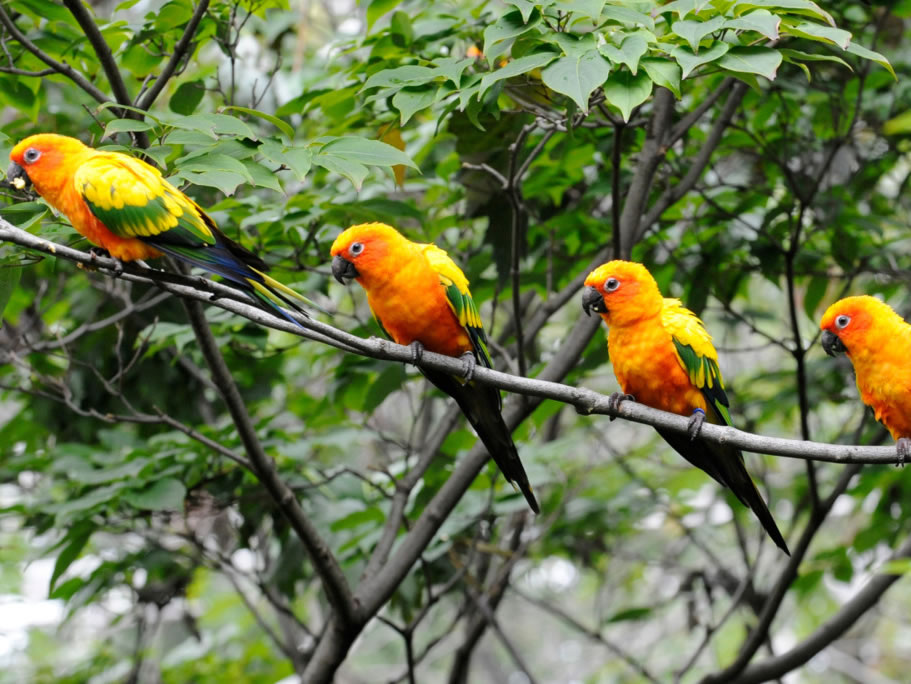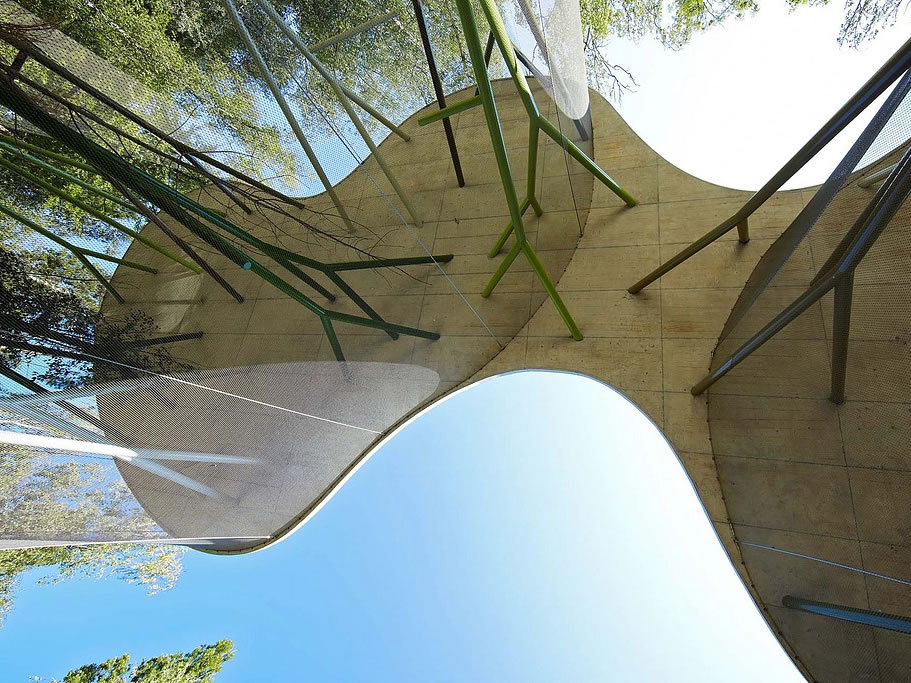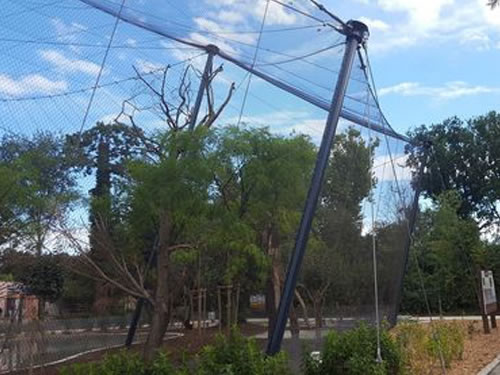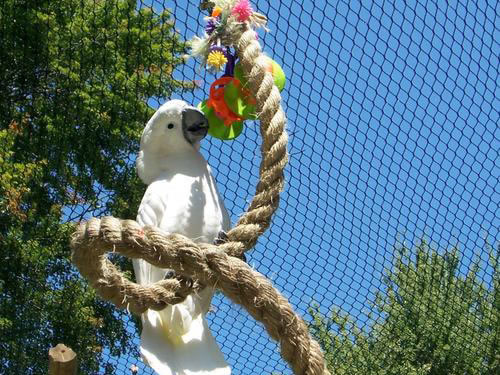Building an aviary is an exciting project, whether you're housing beloved pet parrots, creating a sanctuary for rescued wildlife, or establishing a breeding program. One of the most critical decisions you'll make is selecting the right aviary mesh. It's not just about strength; the mesh size – the dimensions of the individual openings – is paramount for the safety, security, and well-being of your specific birds. Choosing wrong can lead to escapes, injuries, or predator access. Let's dive into how different birds require different mesh specifications.
Why Mesh Size Matters: Beyond Containment
Containment: Obviously, the mesh holes must be small enough to prevent the bird's head or body from passing through.
Safety: Mesh that's too large risks:
Head/Foot Entrapment: Birds can get their heads, beaks, or feet stuck, leading to panic, injury, broken limbs, or strangulation.
Wing Damage: Flapping wings can catch on large mesh, causing sprains, breaks, or feather damage.
Predator Protection: Mesh acts as a barrier against rats, snakes, cats, raccoons, and birds of prey. The openings must be too small for predators to reach through or get a grip.
Preventing Escape of Prey: If you house small birds, the mesh must also prevent them from escaping outwardly.
Visibility & Airflow: Smaller mesh sizes can slightly reduce visibility and airflow compared to larger mesh, but safety is non-negotiable.
Material Matters Too (A Quick Note):
While focusing on size, remember the mesh material is crucial:
Stainless Steel: The gold standard. Highly durable, non-toxic, rust-resistant, and safe for all birds (especially those prone to chewing). Most expensive.
Hot-Dipped Galvanized Steel (HDG): Common and cost-effective. Crucially, it must be washed after galvanizing to remove toxic zinc oxide residues before birds are introduced. Can eventually rust. Not ideal for persistent chewers.
Powder-Coated HDG: Adds a layer of color and extra corrosion resistance, but the coating can be chewed off by determined birds, exposing the underlying zinc.
Avoid: Chicken wire – far too weak, easily breached, and dangerous (birds get caught and injured).
Matching Mesh Size to Bird Size & Type: A Guide
Here's a breakdown of recommended mesh sizes (wire gauge thickness is also important for strength, especially for larger birds):
Tiny Birds (Finches, Canaries, Budgerigars, Small Parrotlets):
Mesh Size: 1/2 inch x 1/2 inch (12.7mm x 12.7mm) or 5/8 inch x 5/8 inch (16mm x 16mm) maximum.
Why: Prevents escape through the mesh itself. Crucially, it also stops predators like rats and small snakes from entering or reaching through. Protects delicate heads and feet. 19-20 gauge wire is usually sufficient.
Caution: Avoid anything larger; even 1-inch mesh is risky for these small birds.
Small to Medium Parrots (Cockatiels, Lovebirds, Conures, Small Parakeets, Quaker Parrots, Pionus):
Mesh Size: 1/2 inch x 1 inch (12.7mm x 25.4mm) or 1 inch x 1 inch (25.4mm x 25.4mm) is common. 5/8 inch x 5/8 inch (16mm x 16mm) is also very suitable and offers better predator protection.
Why: Provides good containment while maintaining visibility and airflow. 1x1 inch is popular but ensure birds cannot get their heads stuck (consider species head size carefully). 16-19 gauge wire recommended.
Note: For very determined smaller parrots (like some conures), 1/2" x 1/2" might be safer to prevent chewing attempts on the wire itself.
Medium to Large Parrots (African Greys, Amazons, Small Cockatoos like Galahs, Eclectus, Small Macaws like Severe):
Mesh Size: 1 inch x 1 inch (25.4mm x 25.4mm) or 1 inch x 2 inch (25.4mm x 50.8mm). Some use 2 inch x 2 inch (50.8mm x 50.8mm) only if the wire gauge is very thick and birds are not prone to sticking heads through.
Why: Balances strength, visibility, and safety. Larger mesh improves airflow significantly. Crucial: If using 1x2 inch or 2x2 inch mesh, ensure the short dimension (1 inch or 2 inch) is significantly smaller than the bird's head width to prevent entrapment. 12-16 gauge wire is essential for strength and to resist bending/chewing.
Caution: 2x2 inch mesh requires careful assessment of the individual bird's size and behavior. It offers less protection against smaller predators reaching through.
Large Parrots & Cockatoos (Large Macaws (Scarlet, Blue & Gold), Large Cockatoos (Umbrella, Moluccan), Large Amazons):
Mesh Size: 2 inch x 2 inch (50.8mm x 50.8mm) or 2 inch x 4 inch (50.8mm x 101.6mm) are typical. Sometimes 1.5 inch x 1.5 inch (38mm x 38mm) is used for extra security.
Why: These powerful birds need very strong mesh (heavy 10-14 gauge wire) primarily to withstand their immense beak strength and climbing/chewing. The mesh size itself is less about body escape (they can't fit through) and more about structural integrity, visibility, and airflow. Ensure head/neck entrapment isn't possible.
Note: Stainless steel is highly recommended for these birds due to their destructive capabilities and sensitivity to zinc.
Birds of Prey (Falcons, Hawks, Eagles, Owls), Large Waterfowl, Game Birds:
Mesh Size: Varies greatly by species size. Smaller raptors (Kestrels) might need 1x1 inch. Larger Hawks/Eagles often use 2x2 inch or 2x3 inch. Owls frequently require smaller mesh (1x1 or 1x2 inch) to protect their sensitive feathers (primaries) from damage ("barbering") on larger mesh.
Why: Strength (heavy gauge 10-14g) is paramount for large raptors. Safety considerations focus on preventing foot entrapment during landing/takeoff and feather protection. Mesh orientation (horizontal vs. vertical wires) can also be a factor for climbing species or feather protection. Predator exclusion (especially for ground predators) is critical.
Key Considerations Beyond Size:
Behavior: Is the bird a determined chewer (macaws, cockatoos)? Opt for thicker gauge stainless steel. Are they prone to climbing or hanging? Ensure the mesh is securely fixed.
Location: Coastal areas need superior corrosion resistance (stainless steel). High wind areas need robust structural support.
Predator Pressure: Areas with high predator populations necessitate smaller mesh sizes and potentially additional security measures (overhangs, dig barriers).
Double Mesh: For extremely small birds or high-risk predators, an inner layer of very small mesh (e.g., 1/2" x 1/2") inside a standard structural mesh adds significant protection.
The Golden Rule: Consult the Experts!
This guide provides a starting point, but always consult with experienced aviary builders, avian veterinarians, or species-specific breeders/keepers before finalizing your mesh choice. Provide them with your exact species list and local conditions. Reputable mesh suppliers specializing in aviaries are invaluable resources.
Choosing the correct aviary mesh size isn't just about building an enclosure; it's about building a safe and secure home where your birds can thrive. Taking the time to get this fundamental element right is an investment in their long-term health, happiness, and safety. Do your research, prioritize safety over cost where necessary, and create a haven perfectly tailored to your feathered residents.
 The Perfect Fit: Choosing Aviary Mesh Size for Different Bird Species
The Perfect Fit: Choosing Aviary Mesh Size for Different Bird Species
 Beyond Bars: Why Stainless Steel Rope Mesh is Revolutionizing Bird Enclosures
Beyond Bars: Why Stainless Steel Rope Mesh is Revolutionizing Bird Enclosures
 The Unsung Hero of Bird Havens: Why Aviary Netting Matters More Than You Think
The Unsung Hero of Bird Havens: Why Aviary Netting Matters More Than You Think
 How to choose Aviary Netting
How to choose Aviary Netting